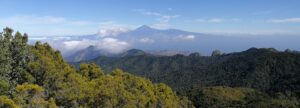Where the laurel forests grow
Agulo
Agulo is considered the most beautiful village in La Gomera. It is particularly attractive due to its old colonial buildings and winding streets. It is imposing in front of a steep red wall on a platform above the sea.
Agulo is one of the most original villages on the island. The landscape is characterized by fertile terraced fields, rugged cliffs and a wonderful view of the sea. From here you can see the mighty Teide on the neighboring island of Tenerife.
Worth seeing is the white church of San Marco, built in the Moorish style according to the plans of the architect Pintor y Ocete. Inside it hides a remarkable figure of Christ by the Canarian artist Perez Donis. Once a year at Easter a big fiesta is celebrated in Agulo. At the climax of the celebrations, young men demonstrate their courage by jumping through the fire - loudly cheered on by the spectators.
Surroundings of Agulo
Right next door, only about 2 km to the east, is the green valley of Hermigua. Also nearby is Juego de Bola, the visitor center of Garajonay National Park near Las Rosas. A beautiful hike leads there from Agulo. Just beyond is a skywalk - the Mirador de Abrante - with a glass projection over the Atlantic.
If you follow the island road from Agulo in the direction of Vallehermoso, you will enjoy beautiful views over La Gomera's north and the wild and romantic coastline. The beautiful village in the north of the island enchants with colonial buildings and winding streets.
Hermigua
The traditional village is located in a romantic valley, surrounded by high mountains in the green north of La Gomera. The beautiful wide valley of Hermigua is known for its particularly mild climate. Hikers in particular are drawn to the unique nature around Hermigua.
Hermigua is located in the most water-rich region on the island. Bananas and other plants thrive in this fertile climate. The region has the largest banana harvest in all of Gomera. The landscape is therefore characterized by wide terraced fields and large banana plantations. One of the landmarks of Hermigua are the twin rocks of Roques de San Pedro. The two fossilized volcanic chimneys are in the Monteforte district.
There used to be a sugar mill here. However, the formerly profitable export product has long since lost its importance for the Canary Islands. Today, bananas are the export hit. If you follow the road to Playa de Hermigua, you will pass the former Dominican monastery El Convento de Santo Domingo on the right, which dates from the 16th century. Inside there are interesting baroque paintings and ceiling panels in the Mudejar style, which combines Moorish and Christian elements.
On the main street is the Los Telares handicraft museum. Historical tools such as old looms (telares), pottery and mill wheels can be viewed here. Lovers of typical island products and musical instruments will find what they are looking for in the town's small shops.
The Museo Etnografico de La Gomera (MEG) on the main street in Hermigua takes visitors back in time. The largest folklore museum on the Canary Island provides information about traditional handicrafts, fishing and animal husbandry in beautiful exhibition rooms. There is also an area dedicated to culinary specialties such as the production of Miel de Palma, gofio and wine. In addition, the Ethnographic Museum, opened in 2007, shows some archaeological finds and informs visitors about the whistled language El Silbo. In the lower part of the valley of Hermigua, on the main road, the parish church of Nuestra Senora de la Encarnacion, built in the 1920s, is a simple church with a high tower. The small church square invites you to rest with the shady laurel trees. The cultural center of Hermigua is housed in the adjoining representative manor house.
Landmarks on Hermigua Beach are the four concrete pillars of El Pescante, a former loading station for bananas, protruding from the sea. Due to the often high waves, the ships could not dock at a pier, but had to be unloaded from there by crane.
The Garajonay National Park with its Canarian jungle stretches out adjacent to the upper valley of Hermigua - a wonderful hiking area. Some hiking trails around Hermigua are among the most beautiful routes on La Gomera, such as the ascent to the El Chorro waterfall. The small river Rio de el Cedro plunges imposingly in an approximately 100 m high waterfall down into the valley. From here you can continue hiking to El Cedro.
Surroundings of Hermigua
About two kilometers further north-west is the village of Agulo, which can be easily reached from Hermigua via the coastal road. If you continue here and follow the island road in the north of La Gomera, you will enjoy beautiful landscapes and views on the drive to Vallehermoso. On the other side of the Hermigua valley, the road leads up to the Garajonay National Park with its mystical forests. Several tunnels lead to the Gomerian capital, San Sebastian. But you can also hike on the lower valley flanks. Some paths around Hermigua, e.g. the ascent to the waterfall to El Cedro, are among the most beautiful hiking routes on La Gomera.
Beautiful valley
The striking volcanic cone Roque Cano towers over the fertile valley with its idyllic town center and a small castle. Green banana plantations, small vineyards and potato fields cover large parts of the area. In earlier times the place was the economic and cultural center of La Gomera. Today it offers a more tranquil ambience and serves as the start and destination for many hikes.
The past splendor of Vallehermoso can still be seen in the ornate houses in the center of the village. A much more functional architecture dominates the more recent buildings.
The Plaza de la Constitution with its fountain and benches forms the lively center of the village. The town hall, bars and banks are all around. The square is enclosed by a roundabout. Small streets branch off radially in all directions.
A little away from the plaza is the remarkable church Iglesia de San Juan Bautista, built by the Canarian architects Pintor and Ocete.
Vallehermoso is also known for its lush orchards. In addition to numerous tropical fruits and apricots, apples, pears and plums also thrive here. Local products from the Vallehermoso area are available for purchase in the market hall on the village square. A shopping trip through the halls is worth it! Here you will find mango, papaya, avocado, passion fruit, bananas and the island's most famous wine, Roque Cano.
Surroundings of Vallehermoso
If you head east from Vallehermoso towards Agulo and Hermigua, you can enjoy wonderful views over the rugged coast and Gomera's north on the drive on the island road.
A short detour leads to the visitor center of the national park near Las Rosas.
From the beautiful place the well-developed road winds through the green valley of Vallehermoso up into the cloud forest of the Garajonay National Park and to the high road. On the way, a small road branches off to Epina and Alojera in La Gomera's west.
In addition, numerous attractive hiking trails lead up into the national park and into the side valleys of Vallehermosos.






